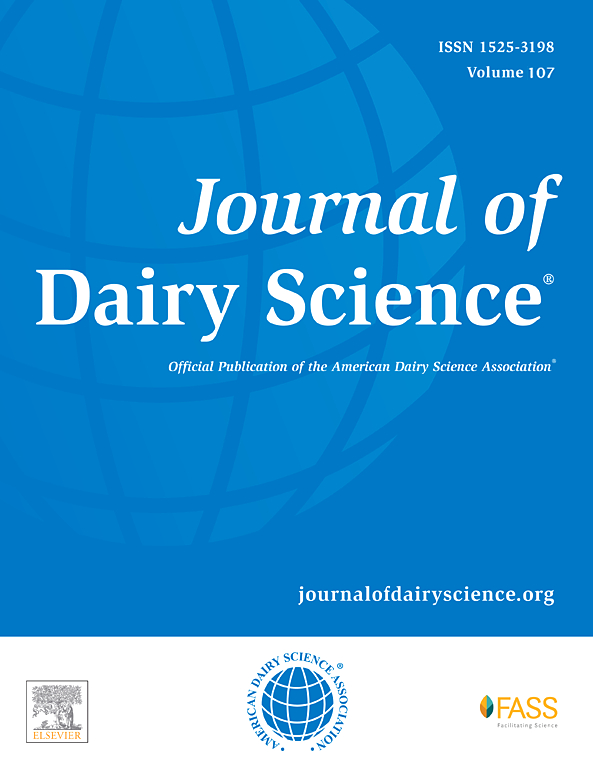每日两次挤奶的奶牛早晚牛奶样品的中红外光谱和预测方程的比较。
IF 3.7
1区 农林科学
Q1 AGRICULTURE, DAIRY & ANIMAL SCIENCE
引用次数: 0
摘要
中红外光谱是一种全球范围内用于定量动物个体和散装罐奶样品中脂肪、蛋白质、乳糖和其他成分浓度的技术。奶牛的牛奶成分和产量在早晨和晚上的牛奶之间存在差异;尽管如此,同一头奶牛在早上和晚上挤奶时产生的光谱差异从未被调查过。数据来自爱尔兰7个研究农场的2602头奶牛。同一头奶牛在24小时内产生的早晨牛奶光谱和相关的晚上牛奶光谱共有199,288份。编辑后,所有牛奶样品的电磁波谱中相同的502波长的光谱数据可用。采用a)早晚光谱吸收值差异的均值和标准差,b)早晚光谱吸收值之间的相关性,以及c) L2距离对同一头奶牛在24 h内产生的早晚牛奶光谱的差异进行了研究,所有这些都是在1)哺乳阶段,2)年份和3)农场中量化的。同一头奶牛在24 h内产生的早晚光谱吸光度值差的平均值(标准差)为0.00097(0.008),在2920 ~ 2947 cm-1波长范围内,其差值均大于0.055。在1469 cm-1 ~ 1473 cm-1光谱范围内,清晨波长吸光度值与各自的傍晚波长吸光度值的相关性均较强(即> 0.80);在1593 cm-1 ~ 1597 cm-1区域,早晚光谱波长之间存在< 0.26的弱相关。这些相关性的趋势通常在哺乳期、年份和农场的不同阶段持续存在。L2距离分析结果表明,泌乳早期的早晚光谱差异大于泌乳后期的早晚光谱差异(P < 0.05);L2距离在不同农场和年份间差异不明显。研究了从早晨光谱数据推导出的预测方程对晚上牛奶光谱数据的影响,反之亦然。氮利用效率(NUE)是动物的一种性状;验证数据集的平均NUE (SD)为22.16(4.86)。在早晨光谱样品上建立并验证的预测的均方根误差为3.49;对于同样的验证,在早晨光谱中,当仅使用晚上光谱建立预测方程时,这一比例增加(P < 0.05)至3.85。同样,在傍晚光谱样品上建立和验证的预测方程的均方根误差为3.46,而在仅使用早晨光谱建立预测方程时,均方根误差增加到3.85 (P < 0.05)。综上所述,同一头奶牛在24 h内产奶的早晚光谱存在差异,特别是在某些光谱区域;这些差异影响了应用预测方程的预测性能。本文章由计算机程序翻译,如有差异,请以英文原文为准。
Comparison of the mid-infrared spectra and prediction equations developed from morning and evening milk samples from twice-a-day milked dairy cows
Mid-infrared spectroscopy is a technology used globally for quantifying the concentration of fat, protein, lactose, and other constituents in the milk samples of both individual animals and bulk tank milk. Differences in the milk components and yield of cows are known to exist between morning and evening milk; nonetheless, differences in the spectra originating from the same cow from morning and evening milkings have never been investigated. Data were obtained from 2,602 dairy cows from 7 research farms in Ireland. A total of 199,288 morning milk spectra with associated evening milk spectra produced by the same cow within 24 h were available. Postediting, spectral data were available on the same 502 wavelengths in the mid-infrared region of the electromagnetic spectrum for all milk samples. Differences between morning and evening milk spectra produced by the same cow in a 24-h period were investigated using (1) the mean and SD of the difference between morning and evening spectra absorbance values, (2) the correlation between the morning and the respective evening wavelength absorbance values, and (3) the L2 distance, all of which were quantified across stages of lactation, years, and farms. The average (SD) difference between the morning and the evening spectrum absorbance values produced by the same cow within 24 h was 0.00097 (0.008), and it was always larger than 0.055 for the wavelengths between 2,920 cm−1 and 2,947 cm−1. The correlation between morning wavelength absorbance values and the respective evening wavelength absorbance values were all strong (i.e., >0.80) in the spectral region of 1,469 cm−1 to 1,473 cm−1; weak correlations of <0.26 existed between morning and evening spectra wavelengths in the region of 1,593 cm−1 to 1,597 cm−1. These trends in correlations generally persisted within different stages of lactation, years, and farms. Results from the L2 distance indicated that early lactation morning and evening spectra were more different from each other than when compared in late lactation; no large differences in the L2 distance across different farms and years were evident. The impact of a prediction equation developed from morning spectral data but applied to evening milk spectral data, and vice versa, was investigated. Nitrogen use efficiency (NUE) was the animal trait explored; the mean NUE (SD) in the validation dataset was 22.16 (4.86). The root mean square error for predictions developed and validated on morning spectra samples was 3.49; this increased to 3.85 for the same validation in the morning spectra when the prediction equation was developed using only evening spectra. Similarly, the root mean square error from predictions developed and validated on evening spectra samples was 3.46, which increased to 3.85 when the prediction equation was developed using only morning spectra. In conclusion, morning and evening milk spectra produced by the same cow within 24 h differ, particularly in some spectral regions; these differences affect the prediction performance of applied prediction equations.
求助全文
通过发布文献求助,成功后即可免费获取论文全文。
去求助
来源期刊

Journal of Dairy Science
农林科学-奶制品与动物科学
CiteScore
7.90
自引率
17.10%
发文量
784
审稿时长
4.2 months
期刊介绍:
The official journal of the American Dairy Science Association®, Journal of Dairy Science® (JDS) is the leading peer-reviewed general dairy research journal in the world. JDS readers represent education, industry, and government agencies in more than 70 countries with interests in biochemistry, breeding, economics, engineering, environment, food science, genetics, microbiology, nutrition, pathology, physiology, processing, public health, quality assurance, and sanitation.
 求助内容:
求助内容: 应助结果提醒方式:
应助结果提醒方式:


